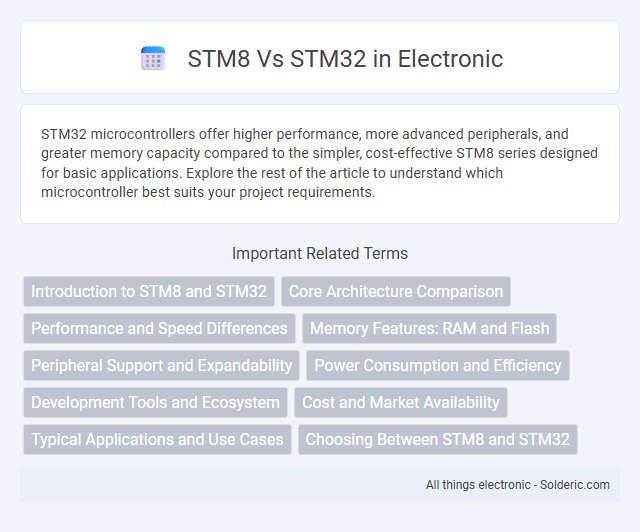STM32 microcontrollers offer higher performance, more advanced peripherals, and greater memory capacity compared to the simpler, cost-effective STM8 series designed for basic applications. Explore the rest of the article to understand which microcontroller best suits your project requirements.
Comparison Table
| Feature | STM8 | STM32 |
|---|---|---|
| Core Architecture | 8-bit STM8 | 32-bit ARM Cortex (M0/M3/M4/M7/M33) |
| Max Clock Speed | 24 MHz | Up to 480 MHz |
| Flash Memory | Up to 128 KB | Up to 2 MB |
| RAM | Up to 6 KB | Up to 640 KB |
| Peripherals | Basic timers, ADC, UART, SPI, I2C | Advanced timers, ADC/DAC, USB, Ethernet, CAN, SDIO |
| Power Consumption | Low power, suitable for simple tasks | Low power modes with advanced features |
| Development Ecosystem | Cosmic, IAR, STM8CubeIDE | STM32CubeMX, STM32CubeIDE, extensive third-party support |
| Typical Applications | Simple embedded control, cost-sensitive designs | Complex applications requiring high performance and connectivity |
| Price | Lower cost | Higher cost due to advanced features |
Introduction to STM8 and STM32
STM8 microcontrollers offer an 8-bit architecture ideal for cost-sensitive, low-power, and simple control applications, delivering efficient performance with compact memory footprints. STM32 microcontrollers feature a 32-bit ARM Cortex core, providing high processing power, extensive peripherals, and real-time capabilities suited for complex embedded systems. Your choice between STM8 and STM32 depends on the application's performance requirements, power consumption, and scalability needs.
Core Architecture Comparison
STM8 microcontrollers feature an 8-bit core architecture optimized for low-power, cost-sensitive applications, offering simplicity and ease of use with limited processing power. In contrast, STM32 microcontrollers are based on 32-bit ARM Cortex cores, delivering higher performance, extensive peripheral integration, and enhanced real-time capabilities suited for complex embedded systems. Your choice between STM8 and STM32 depends on performance requirements, with STM32 providing scalable options across Cortex-M0 to Cortex-M7 cores for advanced processing needs.
Performance and Speed Differences
STM32 microcontrollers outperform STM8 in both processing speed and overall performance due to their advanced ARM Cortex cores operating at higher clock frequencies, often exceeding 100 MHz, compared to STM8's 16-bit architecture capped around 24 MHz. STM32 devices offer enhanced computational capabilities, making them suitable for demanding real-time applications requiring faster instruction execution and superior digital signal processing. Your choice between STM8 and STM32 directly impacts the performance margin, especially for tasks needing rapid data processing and higher throughput.
Memory Features: RAM and Flash
STM32 microcontrollers offer significantly larger RAM and Flash memory compared to STM8, with STM32 devices typically featuring up to 1 MB of Flash and 192 KB of RAM, ideal for complex applications requiring extensive program code and data storage. STM8 microcontrollers provide modest memory sizes, usually up to 128 KB Flash and 6 KB RAM, suitable for simpler, cost-sensitive projects. Your choice depends on memory needs, where STM32 caters to high-performance demands and STM8 suits basic control tasks.
Peripheral Support and Expandability
STM32 microcontrollers offer significantly broader peripheral support and greater expandability compared to STM8, featuring advanced interfaces like USB, Ethernet, and CAN that are often absent in STM8 devices. The STM32 series supports extensive communication protocols and a wide range of timers, ADCs, and DACs, enabling more complex and flexible applications. Your choice of STM32 ensures compatibility with higher-performance sensors and modules, facilitating scalable system designs for demanding projects.
Power Consumption and Efficiency
STM8 microcontrollers exhibit lower power consumption ideal for simple, battery-powered applications with power-sensitive constraints, operating efficiently in sleep and stopwatch modes. STM32 offers higher processing efficiency with advanced ARM Cortex cores, optimizing performance-per-watt for complex, real-time tasks and low-power applications through flexible power modes. Selecting between STM8 and STM32 depends on balancing power efficiency needs with required computational capabilities and peripheral integration.
Development Tools and Ecosystem
STM32 microcontrollers benefit from an extensive development ecosystem supported by STM32CubeMX, Keil MDK, IAR Embedded Workbench, and STM32CubeIDE, enabling efficient configuration and code generation. STM8 devices primarily rely on STM8S standard firmware libraries, STVD (ST Visual Develop) IDE, and Cosmic C compiler, which provide a more limited but straightforward development environment. Your choice between STM8 and STM32 should consider the availability of robust middleware, real-time operating system support, and community-driven resources, typically richer for STM32 platforms.
Cost and Market Availability
STM8 microcontrollers offer a cost-effective solution with prices typically lower than STM32 counterparts, making them ideal for budget-sensitive applications and large-volume deployments. STM8's market availability is robust, with wide distribution channels and extensive legacy support, catering primarily to simple, low-power embedded systems. In contrast, STM32 microcontrollers, while generally higher in price, provide broader feature sets and advanced capabilities, maintaining strong market presence through diverse industry adoption and continuous product innovation.
Typical Applications and Use Cases
STM8 microcontrollers excel in cost-sensitive, low-power applications such as household appliances, simple motor control, and basic sensor interfaces, making them ideal for projects with constrained budgets and limited processing needs. STM32 microcontrollers offer advanced performance, extensive peripherals, and real-time capabilities, suited for complex applications like industrial automation, automotive systems, and IoT devices requiring high-speed processing and connectivity. Your choice depends on the complexity of your project and resource requirements, with STM32 providing scalability and STM8 focusing on simplicity and efficiency.
Choosing Between STM8 and STM32
Choosing between STM8 and STM32 depends on application requirements such as processing power, memory size, and peripheral integration. STM8 offers cost-effective solutions for simple, low-power 8-bit microcontroller applications, while STM32 provides high-performance 32-bit ARM Cortex cores suitable for complex tasks. Evaluate factors like real-time performance, development tools, and ecosystem support to match project needs accurately.
STM8 vs STM32 Infographic

 solderic.com
solderic.com